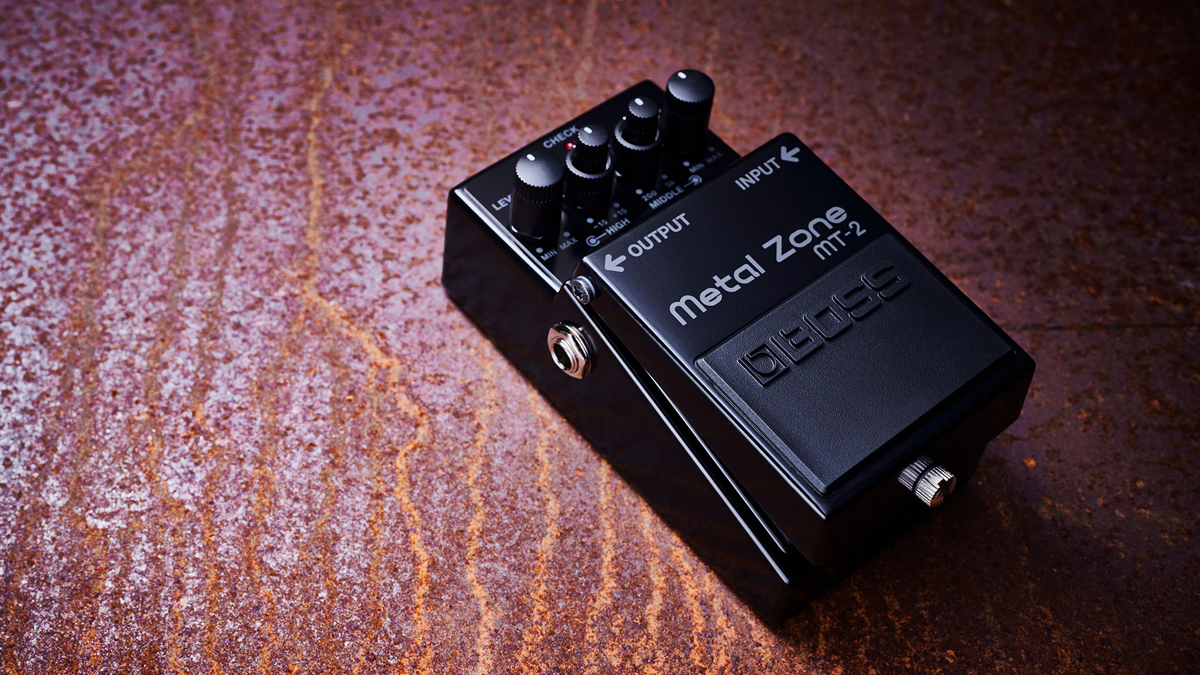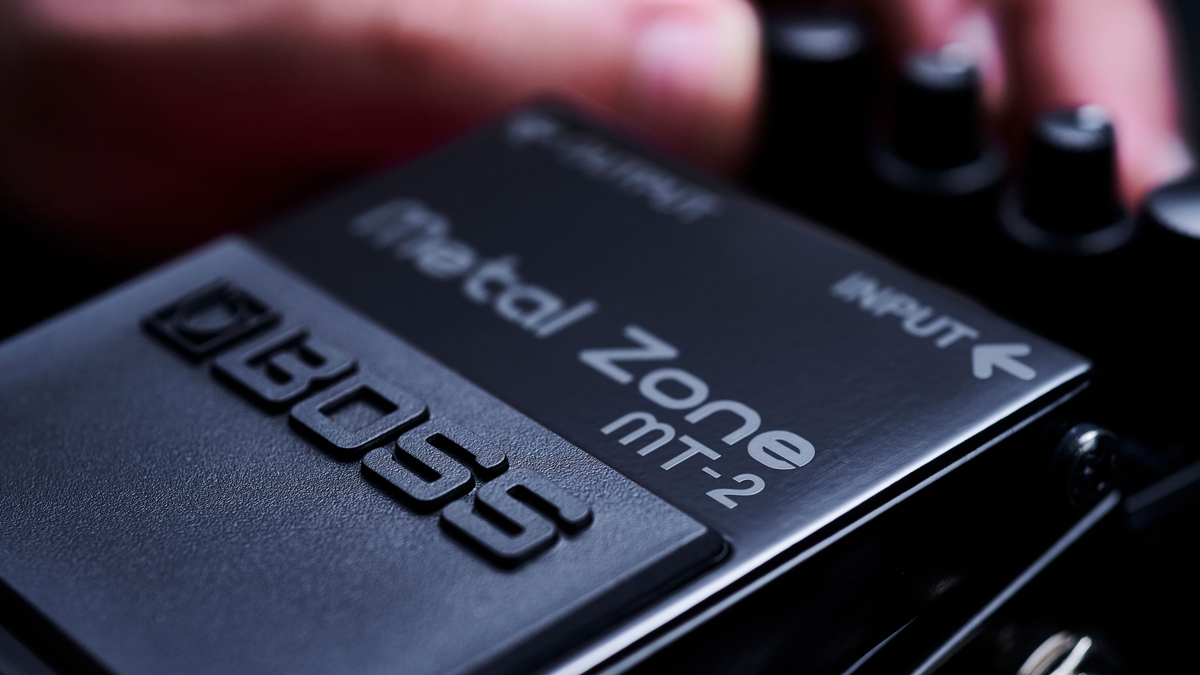How to get killer guitar tones from the Boss MT-2 Metal Zone
The million-selling Boss distortion pedal’s divisive reputation stems from its gargantuan array of tones – we show you how to unearth its best sounds

Like its spiritual predecessor, the Boss HM-2, the Boss MT-2 Metal Zone was intended to replicate a cranked stack of amps, at any volume. However, since its launch in 1991, the sheer versatility of its tones – owing to a complex but powerful EQ section – has received a mixed reception.
Get to grips with its formidable feature set, however, and it can truly deliver on its cranked-stack credentials, with unlimited gain to boot. It’s why the Metal Zone has sold over a million units, an astonishing figure that makes one of the most successful pedals of all time.
Now, 30 years on, Boss is commemorating the best-seller with a limited-edition 30th anniversary model, the MT-2-3A, which is only available throughout 2021, and comes in a none-more-metal grey-on-black colorway.
So, what better time to take a fresh look at one of the most talked-about pedals of all time? In this article, we’ll investigate how to get the best tones, how star players use the MT-2, and the difference between the standard unit and the Waza Craft version.
How do you get the best tones?
The Metal Zone isn’t the most straightforward distortion pedal out of the box, so don’t expect its best sounds to come from all the controls set to 12 o'clock.
That’s down to its dizzying versatility, courtesy of a dual-stage gain circuit and one of the most advanced EQ sections you’ll find on any analog distortion pedal.
For first-time Metal Zone users, the EQ is complicated. There are two active EQ controls with a whopping 15dB of cut/boost, as well as a mids control with the same gain and a variable frequency. Those controls on their own would make a decent compact EQ pedal, and they’re seriously handy for matching the pedal to your amp.
All the latest guitar news, interviews, lessons, reviews, deals and more, direct to your inbox!
But to fully harness the MT-2’s high-gain tones, you need to understand how to use its EQ.

Crucially, the high is not subtle. It's a shelving EQ that depends on the settings across the rest of the pedal. This explains why simply pulling back the treble control doesn't work. Yes, it kills fizz in the tone, but it also results in a much darker guitar sound, as you lose the upper mids.
This is why using the mids control to tame problem frequencies makes sense. Although it's listed as 'Mid freq' on the front panel, it has a very wide range, going from 200Hz all the way to 5kHz. As a result, it's better to think of it simply as a single active EQ control, and disregard the idea it's only for shaping mids. Treat it carefully, as it dictates the entire sound of the distortion.
With that out of the way, let’s get to tone-shaping. We’d advise you start at a very low gain setting, and increase it gradually until you find the sweet spot for your guitar and amp. There's more gain than you'll ever need here!
Now, take some time to really experiment with the EQ, bearing the above points in mind – particularly when using the pedal’s active EQ boosts to overdrive your amp, in conjunction with that highly tweakable midrange. Our preferred setting, in fact, uses the high and low band controls as a boost, with a heavy cut in the upper mids.
Those settings were an attempt to emulate the guitar sounds on Tool's Aenima, and make for one of the pedal’s best all-purpose distortion tones. The controls run like so:

- Level: 2 o'clock
- High: 3 o'clock
- Low: 2 o'clock
- Middle: 10-11 o'clock
- Mid freq: 3 o'clock
- Dist: 10 o'clock
This sounds massive into a tube amp, though you might need to cut a bit of bass at the amp to remove 'thump'.
On that note, it’s important to remember that the amp you’re running into will make a big difference to the overall tone – a good tube combo will beat the solid-state practice amp you might have used as a teenager when you first got your hands on the MT-2.
Of course, while the Metal Zone can be used as a conventional high-gain dirt box, those boostable EQ frequencies mean you can use the pedal to overdrive your amp in different ways, all with a hint of the pedal’s own distinctive character.
For these sounds, try upping the volume while keeping the distortion low and EQ flat, before adjusting to taste.

- Level: 5 o'clock
- High: 12 o'clock
- Low: 12 o'clock
- Middle: 12 o'clock
- Mid freq: 12 o'clock
- Dist: 8 o'clock
How do pro players use it?
There are any number of ways that other guitarists have used the Metal Zone, but three of our favorite methods come from Biffy Clyro's Simon Neil, Converge's Kurt Ballou and YouTuber Ola Englund.
Simon Neil used to use at least two MT-2s in his Biffy Clyro rig, and reportedly still does. For his main gain sound, he's using similar settings to our example posted above, but with the treble and bass not quite as dramatically boosted. The main difference is in how he's set the EQ, with the Mid freq at about 10 o'clock, and the Middle at about 11. This results in some fizz, but it's worth bearing in mind that Neil runs a wet/dry setup, so there's a clean amp to blend into his sound.
Kurt Ballou is a man who knows a thing or two about metal tone, first from his band Converge, but also as the owner of God City Studios. He's a fan of flattening the MT-2’s EQ, turning down the gain and using the level control to smash a tube amp into saturation. From there, you can adjust the EQ on the Metal Zone to your taste, making it a very powerful dirty boost.
Finally, Ola Englund's preamp trick is worth a go. To use the Metal Zone as a preamp, you plug directly into the effects loop return of a tube amp. You can then use the Metal Zone to kick the power section of a decent tube amp into saturation. Its powerful, amp-like EQ and huge amount of gain on tap make it a metal monster when used in this way.
What's the deal with the Waza version?

Launched in 2018, the Waza Craft Metal Zone adds an additional mode over the original with different EQ. S (Standard) mode is the same Metal Zone you love (or hate), while C (Custom) is a new mode aimed at modern metal.
Most users of the original found themselves boosting the bass at least a little, in order to beef up the low mids. The Custom mode seeks to address this, enhancing the low mids and slightly tightening the bass, reducing rumble and (we think) tightening the Q of the bass control itself. The result is a pedal that's more in tune with the modern djent crowd, although it still requires careful dialing in.
Ultimately, the best advice we can give is to forget the memes and experiment: the Metal Zone is a hugely powerful pedal, and taking the time to carefully tweak the EQ can – with a bit of patience – yield formidable results with just about any guitar rig.
And if you’re looking for a more collectable version of the classic design, the grey-on-black MT-2-3A 30th Anniversary Metal Zone is available now – but only for the remainder of 2021.
Alex Lynham is a gear obsessive who's been collecting and building modern and vintage equipment since he got his first Saturday job. Besides reviewing countless pedals for Total Guitar, he's written guides on how to build your first pedal, how to build a tube amp from a kit, and briefly went viral when he released a glitch delay pedal, the Atom Smasher.



